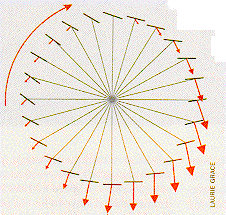Powertrain Overview
The powertrain of a bicycle is comprised
of the person pedalling the bike, the pedals and chain wheel that translate
the motion of the legs into a rotary motion of the chain wheel, the chain that
couples the chain wheel to the rear sprocket, any gear system that alters
the relative rotation rates of the chain wheel and sprocket, the rear wheel
and the tires which transfer forces to the ground. The diagram opposite shows
the magnitude and direction of the forces produced during pedalling by the
U.S. Olympic cyclist Lance Armstrong. It is seen that the major force is applied
during the downstroke, however, a slight pressure is maintained on

From: Scientific American,
June 1996, p. 54
the pedals during the upward motion of the legs. In his high state of training Armstrong generates 525 watts of pedaling power. The power output that can be supplied by less trained people for long periods of time is 225 watts, which demonstrates that the bicycle is a power limited system. Power train design seeks to minimize energy losses, both in the mechanical systems and through aerodynamic, and rolling resistance forces.
| Propulsion |
| Menu |
| Prev |
| Next |